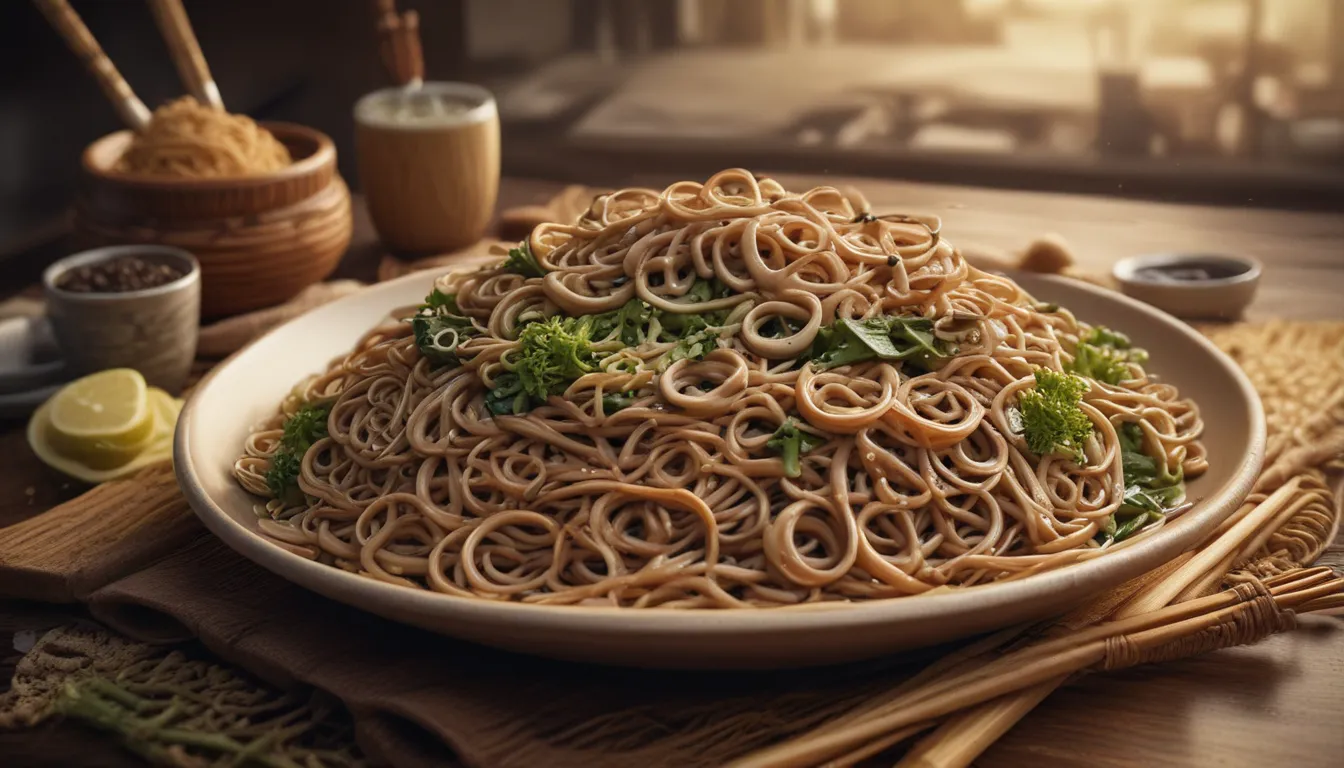The pictures in our articles might not always show exactly what the text is talking about. We use these images to make the article more interesting and eye-catching. They are there to add to the text, but not to replace it or show every detail.
Are you a fan of Japanese cuisine or just curious about trying something new and exciting? Look no further than soba noodles! These thin buckwheat noodles have captured the hearts of food enthusiasts worldwide with their unique taste, versatility, and nutritional benefits. Let's dive into the fascinating world of soba and uncover 20 interesting facts about this beloved Japanese delicacy.
The Story Behind Soba Noodles
Soba noodles, also known as buckwheat noodles, have a rich history rooted in Japanese cuisine. The name "soba" specifically refers to the thin buckwheat noodles that are the star of this dish. Originally made solely from buckwheat flour, modern versions may include a small percentage of wheat flour for improved texture.
Embrace the Versatility of Soba
One of the most appealing aspects of soba noodles is their versatility. These noodles can be enjoyed in a variety of ways, whether served hot or cold, making them a perfect choice for any season. Cold soba dishes, like zaru soba, are particularly popular during Japan's hot summer months.
Nutritional Goodness of Soba Noodles
Soba noodles pack a nutritional punch, offering a great source of dietary fiber, protein, and essential minerals such as manganese and magnesium. They are low in fat and calories, making them a healthier alternative to other noodle varieties.
Gluten-Free Goodness of Soba
Buckwheat, the primary ingredient in soba noodles, is naturally gluten-free, making soba a suitable option for those with gluten intolerances or celiac disease. Just be sure to check the label to ensure the soba noodles are 100% buckwheat.
Savour the Different Varieties of Soba
Explore the world of soba noodles with various types available, each offering its own unique characteristics. From mori soba (plain soba noodles) to kake soba (soba noodles in hot broth) and kitsune soba (topped with sweetened tofu skin), there's a soba variety for every palate.
Experience Handmade Soba Noodles
Traditional soba noodles are crafted with precision and care, often considered an art form in Japan. Skilled soba artisans knead, roll, and cut the dough to create thin, uniform noodles that are a delight to the senses.
Enjoy Soba with Proper Etiquette
When indulging in a bowl of soba noodles, remember to slurp! Making noise while slurping your noodles is considered polite in Japanese culture and enhances the flavor. And of course, it's customary to finish the entire bowl, leaving no noodle behind.
Health Benefits of Soba Noodles
Soba noodles offer a multitude of health benefits. Buckwheat is rich in antioxidants that reduce inflammation and regulate blood sugar levels. Additionally, the nutrients in soba noodles support digestive health and aid in weight management.
Traditional Japanese Dishes Featuring Soba Noodles
In Japanese cuisine, soba noodles are a staple ingredient in many traditional dishes. From tempura soba (soba noodles with crispy tempura) to tanuki soba (topped with crispy tempura flakes) and yakisoba (stir-fried soba noodles), there's a dish for every taste bud.
Cooking Techniques for Perfect Soba Noodles
Cooking soba noodles requires a bit of finesse to achieve the ideal texture. Boil the noodles in plenty of water, then promptly drain and rinse with cold water to remove excess starch and prevent them from becoming mushy.
Cultural Significance of Soba Noodles
Soba noodles hold a special place in Japanese culture, often symbolizing longevity and good luck. It's a common tradition to enjoy soba noodles on New Year's Eve to bid farewell to the old year and welcome the new one with good fortune.
Aesthetically Pleasing Soba Noodles
Not only are soba noodles delicious, but they also present beautifully on a plate. The sleek, dark brown color and slender shape of the noodles make them a favorite among food photographers and Instagram enthusiasts for their aesthetic appeal.
Soba Noodles in Fusion Cuisine
Soba noodles have made their mark beyond Japan's borders, appearing in various fusion dishes worldwide. From stir-fries to salads and even noodle soups, soba noodles add a unique twist to culinary traditions around the globe.
The Art of Making Soba
Handcrafting soba noodles is truly an art form in Japan, with precise measurements and techniques involved in kneading, rolling, and cutting the dough into thin noodles using a traditional soba knife.
A Healthier Alternative to Wheat Noodles
For a healthier noodle option, look no further than soba noodles. With lower calorie and fat content, along with higher fiber and protein, soba noodles offer a nutritious alternative to traditional wheat noodles.
Satisfy Your Crunchy Cravings with Soba Noodles
Soba noodles have a delightful chewy texture that enhances the overall eating experience. This unique texture, achieved through a blend of buckwheat flour and traditional preparation methods, adds to the enjoyment of the dish.
Dive into a Multi-Sensory Soba Experience
Eating soba noodles engages all your senses. From the act of slurping enhancing flavor to the pleasant aroma and satisfying texture, every aspect of enjoying soba noodles contributes to a delightful dining experience.
Quick and Easy Soba Meals
Need a quick and convenient meal option? Look no further than soba noodles! Cook them in just a few minutes and pair them with your favorite toppings and sauces for a satisfying meal on-the-go.
Embrace the Nutty Flavor of Soba Noodles
The distinct nutty flavor of buckwheat flour sets soba noodles apart from other varieties, allowing them to complement a wide range of sauces and toppings for endless flavor combinations.
Unleash Your Culinary Creativity with Soba Noodles
Let soba noodles be your canvas for culinary experimentation. Whether hot or cold, dressed with sauces or garnished with herbs, veggies, or proteins, there's no limit to the delicious dishes you can create with soba noodles.
Conclusion: Savor the Delights of Soba
In conclusion, soba noodles offer not only a delicious dining experience but also cultural and nutritional value. From their humble beginnings in Japan to their global popularity, soba noodles continue to captivate food enthusiasts with their history, production process, and health benefits. So, whether you're a lover of Japanese cuisine or simply seeking a new culinary adventure, don't hesitate to indulge in the wonders of soba noodles.
FAQs: Your Soba Noodle Queries Answered
- What are soba noodles made of?
-
Soba noodles are crafted from buckwheat flour, lending them their unique flavor and texture.
-
Are soba noodles gluten-free?
-
While primarily gluten-free due to buckwheat, some brands may mix in wheat flour, so check the label for gluten-free options.
-
How do you cook soba noodles?
-
Boil soba noodles in salted water for 4-5 minutes until tender, then drain, rinse, and use in your favorite dish.
-
Can you enjoy soba noodles cold?
-
Absolutely! Cold soba noodles are a refreshing option, served with a dipping sauce and toppings for a light and tasty meal.
-
Are soba noodles healthy?
- Soba noodles are a nutritious choice, low in calories, fat, and carbs, while offering fiber and essential nutrients for a balanced diet.
Explore the diverse world of Japanese noodles with our in-depth articles on buckwheat and green tea noodles, offering rich histories and unique flavor profiles to enhance your culinary journey. Trust in our dedication to providing reliable and engaging content, crafted by real users like you, to satisfy your thirst for knowledge about soba noodles and beyond. Happy noodle adventures await as you savor the delights of soba in all its delicious and nutritious glory!






